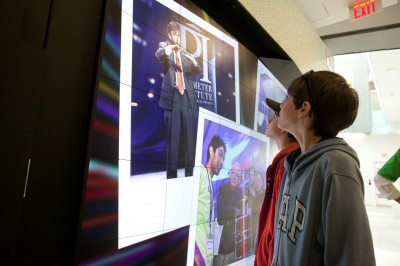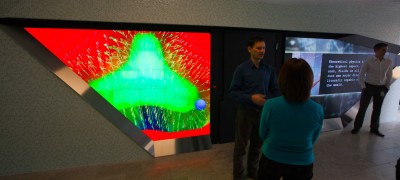By Peter Saunders
While the sign industry has been revolutionized in recent years by advances in technology, there are few places where science is more advanced than the Stephen Hawking Centre at the Perimeter Institute for Theoretical Physics in Waterloo, Ont. World-class research, training and outreach activities take place throughout the facility everyday.
As such, it may have been a daunting task to conceptualize a digital signage deployment to welcome researchers, trainees, students, teachers, members of the public and stakeholders to the centre’s lobby. RP Visual Solutions (RPV) tackled the assignment with an array of 84 MicroTile displays manufactured by Christie in neighbouring Kitchener, Ont. Rather than build a traditional video wall, however, RPV arranged the displays as an irregular hexagon framing a passageway, echoing the lobby’s architectural mix of angles and perspectives.
“This video wall is arranged in a ‘V’ shape, with a narrow base of three MicroTiles wide, working its way up to eight wide at the top of the array,” explains Randy Pagnan, RPV’s president. “An array greater than five tiles benefits from a consolidated back frame, so we constructed one that is adjustable to align each tile, guaranteeing tight seams for the video wall. This allowed the flexibility to provide the architectural look Perimeter was looking to achieve.”
“The unique shape of the media wall, including the functional passageway, is in line with the architect’s vision of the main entrance to the institute,” adds John Matlock, Perimeter’s director of external relations and public affairs. “The whole space came together in a very exciting way.”
A small in-house graphics and audiovisual (AV) team will manipulate and update the media wall’s zones, backgrounds and overall imagery to communicate the institute’s daily news and other messages in creative ways. Abstract concepts in theoretical physics are shared through highly detailed animation.
“In the past, we had plasma displays to impart basic information, including times, dates and names,” says Matlock. “In expanding the research centre, however, the MicroTile array really took us to the next level, where we could bring information to life in new ways, including scientific images and computer-generated animation.”







